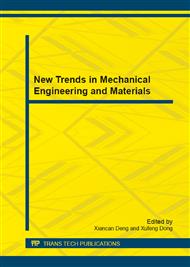[1]
M. Bouazara and M. J. Richard, An Optimization Method Designed to Improve 3-D Vehicle Comfort and Road Holding Capability Through the Use of Active and Semi-Active Suspensions, European Journal of Mechanics, 20(3), (2001) pp.509-520.
DOI: 10.1016/s0997-7538(01)01138-x
Google Scholar
[2]
G.S. Paddan, M.J. Griffin, Evaluation of Whole-Body Vibration in Vehicle, Journal of Sound and Vibration, 253(1), (2002) pp.195-213.
DOI: 10.1006/jsvi.2001.4256
Google Scholar
[3]
K. G. Sung, Y. M. Han, J. W. Cho and S. B. Choi, Vibration Control of Vehicle ER Suspension System using Fuzzy Moving Sliding Mode Controller, Journal of Sound and Vibration, 311(3-5), (2008) pp.1004-1019.
DOI: 10.1016/j.jsv.2007.09.049
Google Scholar
[4]
H. Li and P. Pillay, A Methodology to Design Linear Generators for Energy Conversion of Ambient Vibrations, IEEE Trans. Ind. Appl., 47(6), (2011) pp.2445-2452.
DOI: 10.1109/tia.2011.2168553
Google Scholar
[5]
C.H. Park, J.W. Kim, S.S. Jeong, M.H. Kim, T.G. Park and H.H. Chong, Generating Characteristics of a Cantilever-Type Unimorph Piezoelectric Generator Depending on the Material and Mass, Journal of Applied Mechanics and Materials, 110-116, (2012) pp.217-224.
DOI: 10.4028/www.scientific.net/amm.110-116.217
Google Scholar
[6]
X. Z. Du, H. Yu and Y. Li, The Output Character Analysis of the Piezoelectric Cantilever Power Generator for Ambient Vibration Harvesting, Journal of Applied Mechanics and Materials, 80-81, (2011) pp.865-869.
DOI: 10.4028/www.scientific.net/amm.80-81.865
Google Scholar
[7]
Information on http://www.soundpower.co.jp/index.html
Google Scholar
[8]
N. Shinohara, Energy Harvesting Technologies for Battery-Less Society, Journal of IEICE, 92(8), (2009) pp.695-699.
Google Scholar
[9]
M. Keck, A New Approach of a Piezoelectric Vibration-Based Power Generator to Supply Next Generation Tire Sensor Systems, Proc. of Sensors, 2007 IEEE, (2007) pp.1299-1302.
DOI: 10.1109/icsens.2007.4388648
Google Scholar
[10]
T. H. Ng and W. H. Liao, Sensitivity Analysis and Energy Harvesting for A Self-Powered Piezoelectric Sensor, Journal of Intelligent Material Systems and Structures, 16(10), (2005) pp.785-797.
DOI: 10.1177/1045389x05053151
Google Scholar
[11]
R. Amirtharajah and A. P. Chandrakasan, Self-Powered Signal Processing using Vibration-Based Power Generation, IEEE J. Solid State Circuits, 33(5), (1998) pp.687-695.
DOI: 10.1109/4.668982
Google Scholar
[12]
N. Nagai, Y. Fujikura, Y. Hiroki, S. Hashimoto, M. Kasai, K. Suto, H. Okada and S. Kumagai, Development of a Power Generation Device for Multi-Mode Vibration in Automobiles, Report on The 2012 Annual Meeting Record IEEJ, 7(001), (2012) pp.1-2.
DOI: 10.1109/ias.2012.6374091
Google Scholar
[13]
L. Ljung, System Identification -Theory for the User (2nd edition), Prentice Hall, Englewood Cliffs, NJ, (1999).
Google Scholar
[14]
S. Wakui, S. Hashimoto, H. Takanashi and Y. Nakamura, Fundamentals of Control Engineering Available to Industry, Corona Publishing Co., Ltd., (2012).
Google Scholar


